Untoward otological and audiological consequences of ear candling
Richard Harris, Ph.D.
Brigham Young University; Provo, UT
(Posted March 5, 1999)
|
Given a recent trend toward naturopathic self-treatment, significant attention has been afforded to the practice of ear candling for cerumen removal. A request submitted to the AltaVista search engine for "ear candles" produces almost 900 references! In a December 12, 1998 episode of ABC-TV's popular talk show The View, one of the hostesses (Star Jones) endorsed ear candling in a demonstration (Wednesday, December 16, 1998) only to "debunk" the process in the following episode (Thursday, December 17, 1998), showing the same residue resulting from burning an ear candle outside the ear. This case study, contributed by Richard Harris, Ph.D., FAAA, Brigham Young University, Provo, UT, is presented to indicate that the practice of ear candling is not without risk.
Roy F. Sullivan, Ph.D.
Editor, Video Otoscopy Forum
|
|
A 55 year old female lay midwife was seen at the Brigham Young University Audiology Clinic
after she had burned her ear using an ear candle. The patient reported a severe pain during the use of the ear candle which prompted her visit to our clinic. She reported that "after using the ear candles I wasn't able to hear well out of my right ear and I noticed some bleeding in my ear". Visual inspection did not reveal any blood in the canal. However, this may either been a sanguinous or an ear candle residue which was washed out by the patient prior to coming to the clinic. The patient indicated that she used 10 ear candles over a 10 day period. Figure 1 shows a package of ear candles purchased and used by the patient. Figure 2 shows the package's printed information insert.
Figure 1. Ear candles used by patient
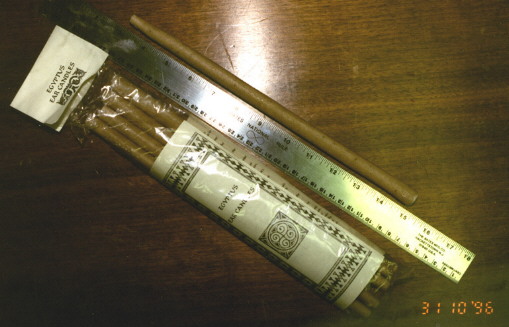
Figure 2. Ear candle package insert (click for enlarged view; 100kB file)

Video otoscopy of her right ear revealed that liquid wax from the ear candle had dripped onto the tympanic membrane (Figure 3).
Figure 3. Ear candle wax on TM
(Click image for enlarged view)
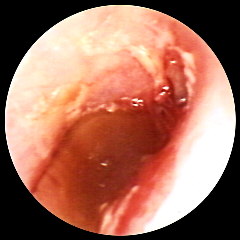
Routine pure tone audiometry revealed a conductive impairment with a 20-25 dB
air-bone gap (Figure 4). Tympanometry presented reduced TM mobility when the ear candle
wax was on the tympanic membrane (Figure 5)
|
Figure 4. Audiometric results obtained with ear candle wax
adherent to the right tympanic membrane
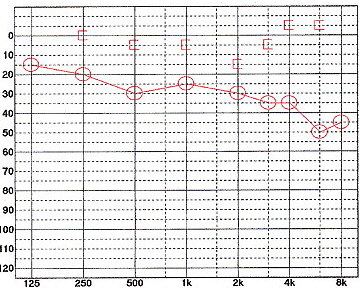 | Figure 5. Tympanometry performed with ear
candle wax on tympanic membrane
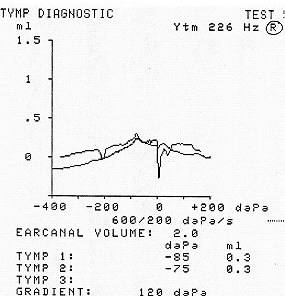 |
She was referred to an otolaryngologist for consultation.
Under a binaural surgical microscope, the otolaryngologist used a surgical hook to remove the plate of ear candle wax from the unanaesthetized surface of the TM. The procedure was without complication. A follow-up audiological evaluation was performed five days after treatment. Video otoscopy shows a significant improvement in appearance of the TM (Figure 6).
Figure 6. Tympanic membrane 5 days after removal of ear candle wax
(Click image for enlarged view)
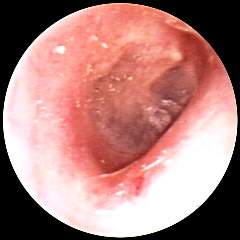
Pure tone audiometry demonstrated some improvement in air conduction hearing acuity, greater in the high frequencies (Figure 7), consistent with restoration of tympanic membrane mobility (Figure 8).
|
Figure 7. Audiometric results obtained 5 days after
removal of ear candle wax from right tympanic membrane.
Red dots = before.
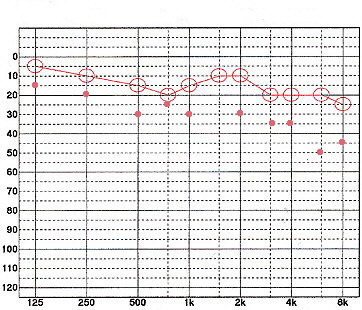 |
Figure 8. Tympanometry performed 5 days
after removal of ear candle wax
from tympanic membrane
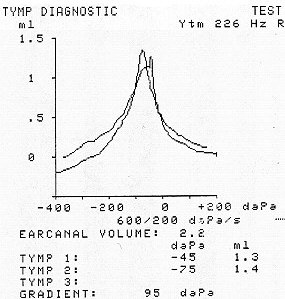 |
|
Figure 9 shows the remnants of the ten ear candles used by the patient in a single self-treatment session.
Figure 9. Remnants of 10 ear candles used by patient over 10 day period
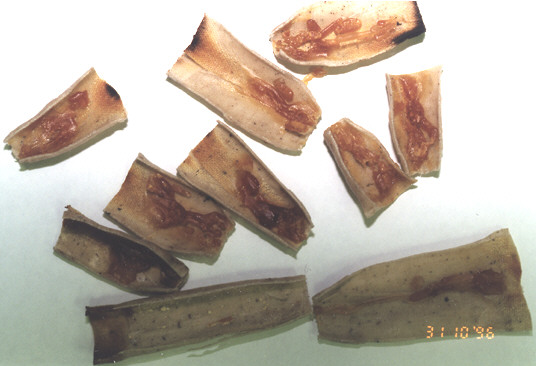
The patient noted that she had been using this technique of self-cerumenectomy for a number of years but this was the first time she had ever burned herself by dripping hot wax onto her tympanic membrane. She easily became convinced that ear candles
no longer constituted a preferred course of treatment for ceruminosis.
Case contributed by
Richard Harris, Ph.D.; Brigham Young University; Provo, UT
Posted: March 5, 1999
|
|